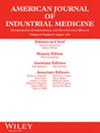Functional disabilities and adverse well-being by COVID-19 and Long COVID history and employment status: 2022 Behavioral Risk Factor Surveillance System
Abstract
Background
Long COVID can lead to functional disabilities and decreased well-being and limit the ability to work. No study has yet assessed associations of SARS-CoV-2-infection and Long COVID with specific measures of well-being and functional disabilities among workers by employment status.
Methods
Using data from the U.S. Behavioral Risk Factor Surveillance System, we assessed the prevalence of functional disabilities and well-being measures among adults of prime working age (25–54 years) by employment status and self-reported COVID-19 and Long COVID history. Within each employment status, we generated adjusted prevalence ratios (aPRs) comparing respondents from each 2022 COVID-19/Long COVID category to respondents in that employment status before the pandemic (2019).
Results
In 2022, prevalences of each functional disability except vision and all adverse well-being measures were highest among the 9.2% of respondents reporting a history of Long COVID. For each outcome, prevalences were lowest for workers and highest among those unable to work. 2022 prevalence of cognitive disability (16.4% of employees, 21.4% of the self-employed) and depression (31.2% and 36.4%, respectively) among workers reporting a history of Long COVID were more than double 2019 levels. Increases in cognitive disability and depression were lower but statistically significant among workers not reporting a history of Long COVID.
Conclusions
The high prevalence of functional disabilities and adverse well-being among workers reporting a history of Long COVID have implications for workers and employers. Also concerning are smaller increases among workers not reporting a history of Long COVID, given the large number of affected workers. Mitigating the effects of Long COVID on workers will involve efforts in multiple domains: reducing incidence, increasing healthcare practitioner awareness, improving diagnosis and treatments, and increasing employer awareness of best practices for accommodating workers with Long COVID.

 求助内容:
求助内容: 应助结果提醒方式:
应助结果提醒方式:


